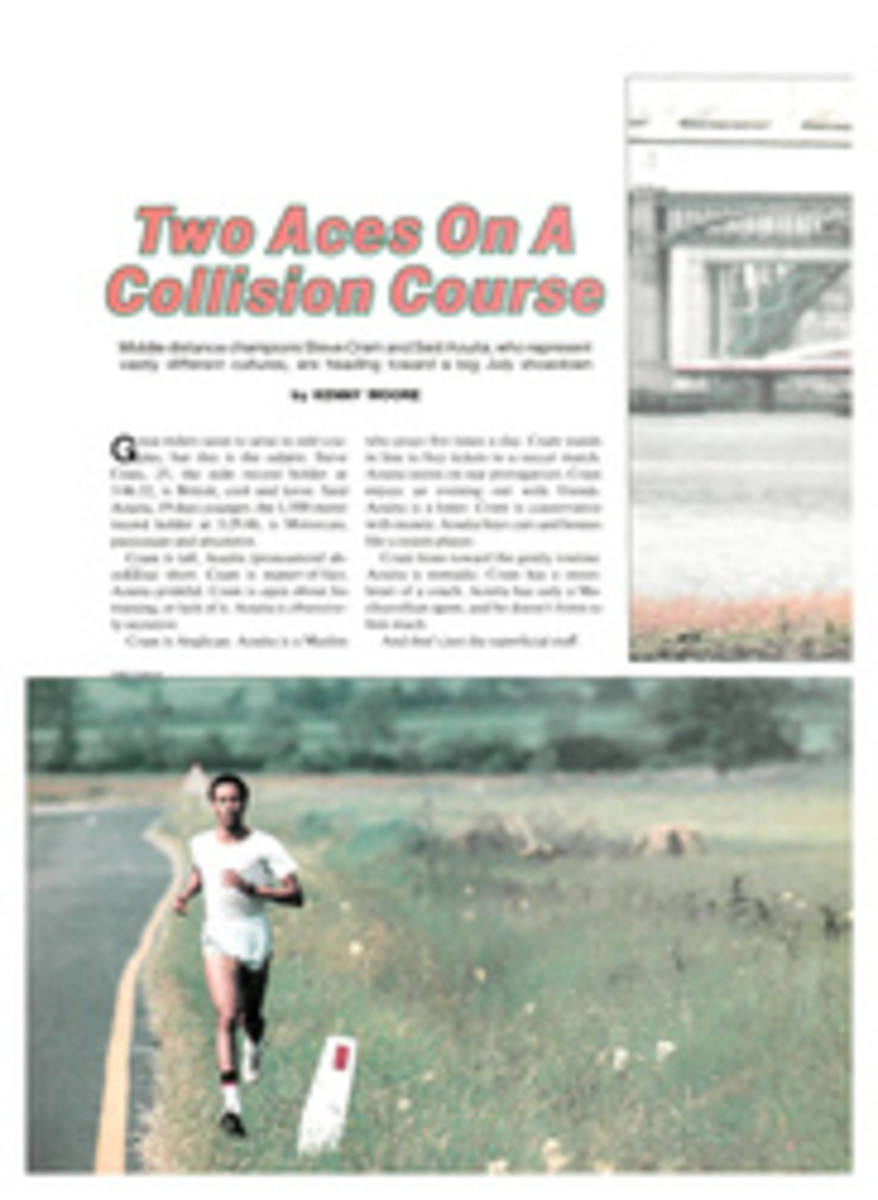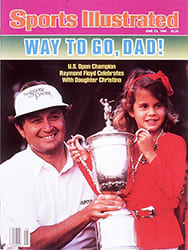
DURING BASEBALL'S STONE AGE, A ROAD TRIP CREATED A WHOLE NEW BALL GAME
Cincinnati's cocky leadoff hitter swings and cracks a line drive over the second baseman's head. The ball rises into the wind and hooks away from the lunging San Francisco rightfielder. The Cincinnati player sprints around first base and heads for second, scarlet calves driving. He dives headlong, his fingers stabbing the base an instant before the second baseman slams the ball against his shoulder.
"Safe!" yells the ump, spreading his arms. The spectators roar their approval of the visitor's hustling play.
Grinning, the Cincinnati player edges away from second and steals third on the next pitch with another dust-spraying slide.
Pete Rose in his prime, tormenting the Giants at Candlestick? No, the hustling ballplayer was 22-year-old "Smiling George" Wright, the Cincinnati Red Stockings' all-everything shortstop and leading hitter, bedeviling the Pacific Base Ball Club at San Francisco's Recreation Grounds on Sept. 29, 1869. All told, he went 6 for 10 on the day, stole seven bases and scored eight times.
The Red Stockings of Cincinnati were America's first pro team. In the years prior to the Civil War, baseball had been controlled largely by amateur "gentlemen's" clubs, whose members regarded play-for-pay as vulgar. As the popularity of spectator sports surged after the war, however, many teams began to charge admission, distributing the take among their players—and some even covertly paid salaries to a few star performers. In 1869, a group of Cincinnati businessmen, inspired by a loss to a touring team from Washington, took things a step further. They hired a chap named Harry Wright to form a crack baseball squad.
The English-born son of a pro cricketer, Wright had played cricket for a living in New Jersey and also excelled at baseball, which he had learned growing up in New York. Wright recruited top players—including his talented brother George—from around the nation and openly signed them to contracts before the start of the '69 season. Harry himself was not only the team's manager but its captain, centerfielder and relief pitcher.
In the summer of '69 the newly professional Red Stockings set off on a tour of the country, taking on all challengers. One of their first stops was New York, where they toppled Boss Tweed's powerful Mutuals 4-2 in a confrontation regarded by many contemporaries as the best game of the sport's infancy. In Philadelphia they beat the renowned Athletics 27-18; in Cincinnati they routed the New Orleans Southerns 35-3; and in St. Louis the Empires, "Champions of Missouri," crumbled 31-14. The Stockings continued to blow away the opposition as they swept through 22 cities in all on their way west.
By the time they arrived in California in September, they boasted an unprecedented streak of 44 straight victories and a larger-than-life legend; they had become known as the "invincible nine," and their exploits were flashed by telegraph throughout the country. On the evening of Sept. 23 in San Francisco, more than 2,000 people mobbed the Broadway Wharf to greet them when they arrived by river steamer from Sacramento. They were scheduled to stay 11 days and play three of San Francisco's amateur clubs—the Eagles, the Pacifies and the Atlantics. Already, poster-sized color lithographs of the players were being sold throughout the city.
All of the games were played at the Recreation Grounds, at the corner of Folsom and 25th. Opened two years before by Australian immigrants August and William Hatton, it was the scene of circuses and bike races, as well as cricket and baseball games—anything that would draw a paying crowd. It was William Hatton who had thought of inviting the Red Stockings to play there.
The guests immediately set about displaying their prowess on the field. During their first four days in the City by the Bay, they played two baseball games with the Eagles and a five-hour cricket match, inflicting, according to a local writer, a "Waterloo" on their opponents each time.
The streets around the field were chaotic during the games, and the park was generally overflowing by the time the team members arrived. Over the wooden clubhouse the contending teams' pennants fluttered beside Old Glory with its 37 stars.
The entrance of the Red Stockings did not disappoint the crowd. Their revolutionary outfits were the prototypes of today's uniforms. They wore white flannel shirts bearing a red C on the chest, duckbilled white linen caps with rounded crowns, white flannel knickers and bright red stockings running from knee to shoe top. The getup "shows their calves in all their magnitude and rotundity," wrote an admiring reporter in the San Francisco Chronicle.
But there was more to the visitors than their legs and their costumes. "The Ohio Club," said the Morning Call, "is under regular military discipline." "Captain Harry" drilled his young players incessantly, and he exercised authority without raising his voice or swearing. His outstanding collection of players included a big first baseman named Charlie Gould, the sure-handed "human bushel basket"; fuzz-cheeked rightfielder Cal McVey, at 19 the youngest and burliest slugger on the team; and, behind the plate, Doug Allison, the "Quaker City Boy," who stood fearlessy upright just behind the "striker" (later the batter), his reflexes enabling him to stop balls "hot from the pitcher" or ricocheting off the bat. Allison's mauled hands and bruised body testified to the wounding potential of the ball before the development of padded gloves, face masks, shin guards and chest protectors.
The third game of the San Francisco tour pitted the Pacific Base Ball Club against the "Porkites of Porkopolis," as one pundit had dubbed the visitors in honor of Cincinnati's thriving hog industry. Increasingly dispirited as George Wright's leadoff blow was followed by an uninterrupted stream of Red Stocking hits, the Pacifies, wearing traditional long trousers and flat Civil War-style caps, grimly manned their positions. They were the second-oldest of the city's 50-odd teams, having been organized in 1862 by James and William Shepard, both of whom had played with Harry Wright on Knickerbocker squads in New York in the late '50s and had helped bring the New York style of play to the West Coast. Smart money was on the home team—not to win, but to score more than four runs. Their local rivals, the Eagles, had reached that modest figure in both of the previous contests, and gamblers were wagering that the Pacifies would profit from observing the Eagles' mistakes.
But all such bets riding on this hope turned out to be a losing proposition. The Pacifies did have one moment of glory, in the first inning, owing partly to the San Francisco weather. S.H. Wade stroked a grounder that caromed off Gould's cold hands at first base. Wade then stole second, went to third when the catcher threw the ball into centerfield and scored on a wild pitch by Asa Brainard.
But there was little to celebrate after that. The Red Stockings unleashed a 66-run onslaught in the first five innings that ended, mercifully, in the sixth, when, with the score 66-4, they deliberately hit into outs as dusk descended. The Pacifies were limited to four hits and four runs, and the disappointed bettors dug deep for coins and greenbacks.
Indeed, the scores of Cincinnati's victories in San Francisco showed remarkable consistency: 35-4 and 58-4 over the Eagles; 66-4 and 54-5 against the Pacifies; a 76-5 thrashing of the Atlantics; and a mere 46-14 rout of the All-California Nine, the best players from the three home teams.
Although many now-outmoded rules were still in force—the pitcher delivered underhand from 45 feet away, for instance—the Red Stockings' play was modern compared with that of their opponents, and reporters took note of their many innovations. At the plate, the San Francisco players swung for the fences, often lofting "sky balls" to the outfielders; even on grounders, they would pause "to see where the ball went, and then attempt to make the first base, where they would invariably be put out." The Red Stockings, on the other hand, would hit the ball "about four inches above the ground, making what is called a 'daisy cutter'...hardest for the fielders to stop."
On the base paths, the locals "dillydallied around their first until too late, and seldom made their second except when a ball was sent away out in the field." But the Red Stockings took off for the next base "before the pitcher's arm was drawn all the way back, and the swiftest ball a catcher could throw could not stop them."
When it came to pitching, according to one writer, the locals "remained firm in their position, with the legs spread...having barely the force of the body from the waist to impel the ball." The visiting pitchers stepped forward while throwing, thus giving the ball greater impetus. And Wright's "slow twisters" proved as baffling as Brainard's "chain lightnings."
On defense, too, the Red Stockings played more aggressively. The locals remained in fixed positions, while the Red Stockings ranged over the field and employed, in effect, two field captains: Harry Wright directing the shortstop and outfielders, while catcher Allison communicated by "telegraphic signals to the pitcher and base-keepers the proper thing to do at the right moment." In one instance, as a sky ball descended, "the captain called, 'McVey!' and he put himself in position to catch it, but the captain also called, 'Wright!' in the same breath, and the shortstop ran and dropped on his knee under McVey's hands, so that if missed by the first [the ball] could still be caught...."
On a more elevated note, the Red Stockings were praised for their "urbanity," never showing a "single instance of exulting over their opponents, carping at the play of each other, nor disapproval at the decision of the umpire...." In short, they had transformed themselves into professional ballplayers.
On the visitors' last night in San Francisco, the local clubs hosted a lavish banquet for them, at which a glass was raised in toast: "To the Red Stockings—may they never meet the wash in which they are bleached." Perhaps he should have said dyed, for imitators—a profusion of Blue Stockings, Brown Stockings and Gold Stockings—soon sprang up in the cities and towns where the Red Stockings had hammered home their lesson that amateur teams could no longer compete with them. The very next season saw the Red Stockings defeated by several new professional teams, including Chicago's White Stockings. In the following year, 1871, came the formation of the first association of pro clubs, and five years after that the National League was established.
In the midst of Cincinnati's visit, a column in the Morning Call summed up the Red Stockings' impact: "The Base-Ball season has commenced, and with an energy unknown before."
ILLUSTRATION
JEAN FRANCOIS ALLAUX
Darryl Brock lives in Berkeley, Calif., and is writing a novel about the Red Stockings.

